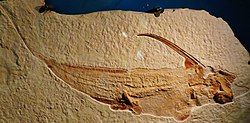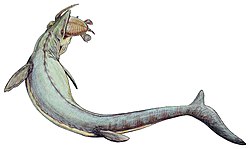Vertebrate paleofauna
Cartilaginous fishes
Based on Case (1996) and Boles et al (2024): [3] [9]
Chimaeras
| Chimaeras of the Hornerstown Formation | ||||||||
|---|---|---|---|---|---|---|---|---|
| Genus | Species | Location | Stratigraphic position | Abundance | Material | Notes | Images | |
| Edaphodon | E. agassizi | Danian | Tooth plates | A callorhinchid chimaera. |  | |||
| E. mantelli | Danian | |||||||
| E. mirificus | Maastrichtian | |||||||
| E. stenobyrus | Maastrichtian | |||||||
| Ischyodus | I. bifurcatus | Maastrichtian, potentially Danian | Tooth plates, jaw elements | A callorhinchid chimaera. |  | |||
| I. thurmanni | Maastrichtian | |||||||
| I. williamsae | Danian | |||||||
Sharks
| Sharks of the Hornerstown Formation | ||||||||
|---|---|---|---|---|---|---|---|---|
| Genus | Species | Location | Stratigraphic position | Abundance | Material | Notes | Images | |
| Araloselachus | A. cuspidatus | Maastrichtian | Teeth | A sand shark. [10] |  | |||
| Carcharias | C. teretidens | Danian | A relative of the sand tiger shark. |  | ||||
| Cretalamna | C. appendiculata | Maastrichtian & Danian | A megatooth shark. |  | ||||
| Heptranchias | H. howellii | Maastrichtian | A relative of the sharpnose sevengill shark. |  | ||||
| Hexanchus | H. microdon | Danian | A sixgill shark. |  | ||||
| H. sp. | Maastrichtian & Danian | |||||||
| Otodus | O. obliquus | Danian | A megatooth shark. |  | ||||
| Odontaspis | O. sp. | Danian | A sand shark. |  | ||||
| Palaeocarcharodon | P. sp. | Danian | A megatooth shark. |  | ||||
| Palaeogaleus | P. vincenti | Maastrichtian & Danian | A houndshark. |  | ||||
| Palaeohypotodus | P. rutoti | Danian | A sand shark. |  | ||||
| Pseudocorax | P. affinis | Maastrichtian | A pseudocoracid shark. |  | ||||
| Scapanorhynchus | S. texanus | Maastrichtian | A goblin shark. [11] |  | ||||
| Scyliorhinus | S. gilberti | Danian | A catshark. |  | ||||
| Sphenodus | S. lundgreni | Maastrichtian | A orthacodontid shark. |  | ||||
| Squalicorax | S. pristodontus | Maastrichtian | A crow shark. |  | ||||
| Squalus | S. minor | Maastrichtian & Danian | A spurdog. |  | ||||
| S. sp | ||||||||
| Squatina | S. sp. | Maastrichtian | An angelshark. |  | ||||
| Weltonia | W. ancistrodon | Danian | A cow shark. | |||||
| Xampylodon | X. brotzeni | Maastrichtian | A cow shark. |  | ||||
Rays
| Rays of the Hornerstown Formation | ||||||||
|---|---|---|---|---|---|---|---|---|
| Genus | Species | Location | Stratigraphic position | Abundance | Material | Notes | Images | |
| Aetomylaeus | A. striatus | Maastrichtian | Teeth | An eagle ray. [10] |  | |||
| Dasyatis | D. crosswickense | Danian | A whiptail stingray. Type locality for species. |  | ||||
| Hypolophites | H. hutchinsi | Danian | A whiptail stingray. Type locality for species. | |||||
| Hypolophodon | H. sylvestris | Danian | A whiptail stingray. | |||||
| Ischyrhiza | I. mira | Maastrichtian | A sclerorhynchid sawskate. [10] |  | ||||
| Rhinoptera | R. sp. | Maastrichtian | A cownose ray. |  | ||||
| Rhombodus | R. laevis | Maastrichtian | A rhombodontid ray. |  | ||||
| Viperecucullus | V. kuehnei | Danian | A whiptail stingray, type locality for the species and genus. | |||||
Ray-finned fishes
| Actinopterygii of the Hornerstown Formation | ||||||||
|---|---|---|---|---|---|---|---|---|
| Genus | Species | Location | Stratigraphic position | Abundance | Material | Notes | Images | |
| Acipenser | A. cf. albertensis | Maastrichtian | A sturgeon. [3] |  | ||||
| Anomoeodus | A. phaseolus | Maastrichtian, potentially Danian | 8 teeth | A pycnodont. One tooth is known from the Danian section of the formation, which would be the latest record of this genus and prove its occurrence in the Cenozoic; however, it may have been reworked from lower layers. [3] |  | |||
| Atractosteus | A. sp. | Maastrichtian & Danian | 11 teeth | A gar. First record of gars from eastern North America during the Paleocene. [3] |  | |||
| cf. Bananogmius | cf. B. sp. | Maastrichtian | A plethodid tselfatiiform. [3] [10] |  | ||||
| Dercetidae indet. | Maastrichtian & Danian | 27 flank scales | A dercetid aulopiform. The first evidence in eastern North America of the Dercetidae surviving the K-Pg extinction event. [3] | |||||
| Enchodus | E. ferox | Maastrichtian | An enchodontid aulopiform. The E. gladiolus remains are the first record of the species in eastern North America. [3] |  | ||||
| E. gladiolus | 8 teeth | |||||||
| Iridopristis | I. parrisi | Sewell, New Jersey | Danian | 3 partial articulated specimens, including a near-complete skull. [8] | A stem-lineage member of Holocentridae. The earliest known definitive holocentrid. Type locality for genus and species. [8] | |||
| Paralbula | P. marylandica | Maastrichtian & Danian | 23 teeth | A phyllodontid elopomorph. First evidence of P. marylandica existing during the Cretaceous, indicating that it survived the extinction event. [3] | ||||
| Phyllodus | P. paulkatoi | Maastrichtian | 1 tooth plate | A phyllodontid elopomorph. First known occurrence in eastern North America. [3] | ||||
| Saurocephalus | S. lanciformis | Danian | 1 tooth | A saurodontid ichthyodectiform. First known occurrence in eastern North America and first known occurrence of ichthyodectiforms as a whole in the Paleocene and Cenozoic. [3] |  | |||
Reptiles
Birds
A number of fossil birds are known from the greensands of the formation. The Hornerstown serves as the type locality for all these genera and species:
| Birds of the Hornerstown Formation | ||||||
|---|---|---|---|---|---|---|
| Genus | Species | Location | Stratigraphic position | Abundance | Notes | |
A. rex | ?earliest Paleocene [12] [13] | A waterfowl potentially related to the magpie-goose. [3] [14] | ||||
G. velox | A potential wader. [3] [14] | |||||
L. edwardsianus | A laornithid wading bird. [3] [14] | |||||
| Novacaesareala | N. hungerfordi | A potential tropicbird. [3] [14] | ||||
P. littoralis | A potential wader. [3] [14] | |||||
P. vagans | ||||||
T. priscus | A potential wader. [3] [14] | |||||
T. glauconiticus | A potential seabird. [3] [14] | |||||
Non-avian dinosaurs
| Dinosaurs of the Hornerstown Formation | ||||||
|---|---|---|---|---|---|---|
| Genus | Species | Location | Stratigraphic position | Abundance | Notes | |
| Hadrosauridae indet. | Maastrichtian | A hadrosaurid ornithischian. [3] | ||||
The tyrannosauroid Dryptosaurus is sometimes referred to this formation, as its remains were found in the New Egypt Formation, which is sometimes considered a part of the Hornerstown. [15]
Crocodylomorphs
| Crocodylomorphs of the Hornerstown Formation | ||||||||
|---|---|---|---|---|---|---|---|---|
| Genus | Species | Location | Stratigraphic position | Abundance | Material | Notes | Images | |
| Borealosuchus | B. threeensis | Maastrichtian | Lower jaw, postcranial remains | A eusuchian. Type locality of species. [3] [16] |  | |||
B. harlani | Maastrichtian & Danian | Remains including lower jaw of a juvenile individual [17] | An early caiman. [3] [17] | |||||
| B. tuberculatus [10] | Maastrichtian | |||||||
| Hyposaurus | H. rogersii | Maastrichtian & Danian | A dyrosaurid. [3] [18] | |||||
| cf. Procaimanoidea | P. sp. | Maastrichtian | A caiman. [3] |  | ||||
| Thoracosaurus | T. neocesariensis | Maastrichtian & Danian | A gavialoid. [3] |  | ||||
Plesiosaurs
| Plesiosaurs of the Hornerstown Formation | ||||||||
|---|---|---|---|---|---|---|---|---|
| Genus | Species | Location | Stratigraphic position | Abundance | Material | Notes | Images | |
| " Plesiosaurus " | "P." brevifemur | Maastrichtian | An indeterminate plesiosaur known from a well-documented specimen, now lost. [19] [20] | |||||
Turtles
| Testudines of the Hornerstown Formation | |||||||
|---|---|---|---|---|---|---|---|
| Genus | Species | Location | Stratigraphic position | Abundance | Notes | Images | |
| Adocus | A. agilis [19] | Maastrichtian | An adocid. [3] |  | |||
| A. beatus | |||||||
| A. syntheticus [19] | |||||||
| Agomphus | A. pectoralis | Maastrichtian | A kinosternoid related to Dermatemys . [3] [21] |  | |||
| Bothremys | B. sp. | Maastrichtian | A bothremydid side-necked turtle. [3] | ||||
| Euclastes | E. wielandi | Maastrichtian & Danian | A sea turtle. [3] |  | |||
| Lytoloma | L. jeanesii | Maastrichtian | A sea turtle. [19] | ||||
| Osteopygis | O. emarginatus | Maastrichtian | A macrobaenid. [19] | ||||
| Peritresius | P. ornatus | Maastrichtian | A sea turtle. | ||||
| Taphrosphys | T. sulcatus | Maastrichtian | A bothremydid side-necked turtle. [3] | ||||
| T. strenuus | |||||||
Mosasaurs
| Mosasaurs of the Hornerstown Formation | ||||||||
|---|---|---|---|---|---|---|---|---|
| Genus | Species | Location | Stratigraphic position | Abundance | Material | Notes | Images | |
| Halisaurus | H. platyspondylus | Maastrichtian | A halisaurine. Type locality of the genus and species. |  | ||||
| Mosasaurus | M. hoffmanni (=Nectoportheus validus) [19] | Maastrichtian | Pterygoid, teeth, vertebrae [3] [7] | A mosasaurine. This formation contains some of the last known remains, comprising individuals killed during the mass mortality event that formed the MFL. [3] A very large specimen is known. [7] |  | |||
| Plioplatecarpus | P. sp. | Maastrichtian | A plioplatecarpine. |  | ||||